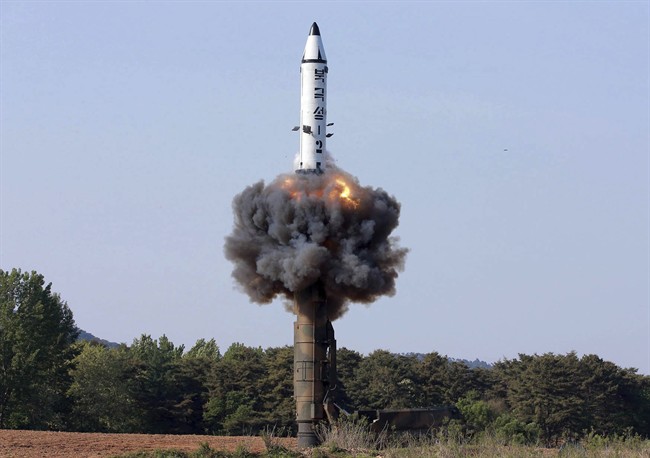When simulating missile attacks from North Korea or Iran, the U.S. military says its defense system and network of radars allow it to successfully track and destroy incoming warheads.

But test conditions do not accurately mimic those of wartime and critics are skeptical the country can truly defend itself, even after spending $40 billion over 18 years of research and development.
Coverage of North Korean missile tests on Globalnews.ca:
On May 30, the U.S. Missile Defense Agency (MDA) held its 10th successful test, in 18 attempts, of the Ground-based Midcourse Defense (GMD) system, a network of radars, anti-ballistic missiles and other equipment designed to protect the United States from intercontinental ballistic missiles (ICBMs) launched from North Korea or Iran.
Lt. Gen. Sam Greaves, the MDA’s director, told Reuters the defense met expectations and shot down the incoming warhead.
“This was a realistic and stressing test, and it simulated an actual attack on the U.S.,” he said in an emailed statement.
READ MORE: North Korea’s missile could hit Canada, and we might not be protected: experts
Within a few days of the test, the Pentagon’s testing office for the first time in five years upgraded its assessment of the U.S. ability to defend against incoming ICBMs like the ones North Korea is developing. Its assessment went from “limited capability to defend the U.S.” to “demonstrated capability.”
The test, however, took place during daytime and intercepted a single incoming missile. Few experts expect either of those assumptions to be likely if North Korea launched an attack.

Get breaking National news
“We have to get into the realism” of what North Korea would be most likely to launch at the United States, said Riki Ellison, chairman of the Missile Defense Advocacy Alliance, which aims to educate the American public and rally support for missile defense.
While calling the simulation on May 30 the “most difficult and challenging test MDA has done,” Ellison said the system needs to be tested more strenuously against threats such as multiple warheads that employ devices to confuse missile defenses.
‘Fire and fury’
The military’s ability to defend the United States is under greater scrutiny as President Donald Trump and North Korean leader Kim Jong Un trade threats.
North Korea said on Wednesday it is considering plans for a missile strike on the U.S. Pacific territory of Guam, just hours after Trump told the country that any threat to the United States would be met with “fire and fury.”
Scientists on all sides agree there is nothing easy about detecting, tracking and intercepting a nuclear missile. It is a mission often described as akin to hitting a bullet with another bullet, and there is no consensus on the quality of the MDA’s testing.
The MDA, which combs through its test data for months before drawing in-depth conclusions, has released just enough information about the May 30 test to show how it was deemed a success.
READ MORE: Kim Jong-un calls missile test a ‘gift’ to ‘American bastards’
Physicist Laura Grego, who studies missile defense at the Union of Concerned Scientists, has examined the publicly available data and disagrees with the Pentagon’s assessment that the system worked against a realistic threat.
She says the test did not address the possibility of North Korea using complex countermeasures and decoys to confuse the anti-ballistic missile‘s “kill vehicle,” which pops off the top of the defending missile above the earth’s atmosphere and seeks out and destroys the attacking missile‘s warhead.
Decoys and countermeasures are meant to dupe the kill vehicle into attacking the wrong object, allowing the real warhead to pass unscathed toward its objective.
“When you look at the objects in the onboard sensor’s field of view they have very different brightness,” Grego said, adding that an adversary would make the decoys look very similar to the warhead to confuse the kill vehicle.

Phil Coyle, a former head of testing and evaluation at the Pentagon who has also reviewed the publicly-available test data, said that instead of using decoys meant to look and act identical to the dummy nuclear warhead, the decoys looked like “specks of sand” compared to the “bright” dummy warhead.
He concluded the infrared signature of the countermeasures was so low they would have been easily distinguished and avoided by the Raytheon-built kill vehicle.
However, Greaves said that the “MDA tests against the types of threats we expect our adversaries could employ.”
READ MORE: North Korea, Donald Trump continue to trade escalating threats of fire
Still, Coyle said that GMD flight intercept tests are scripted for success in a variety of ways. For example, the GMD system has never succeeded in hitting its target at night, and all but one past GMD flight intercept tests have been conducted during the daytime, also taking care that the sun is not in the field of view of the kill vehicle.
Coyle said the sun could blind or confuse the infrared detectors on the kill vehicle.
Greaves said the GMD’s radars do not rely on the sun’s rays and therefore “the time of a test or the existence of daylight would not be a factor to these systems.”
Grego said the sun’s rays heat the targets and decoys, giving the kill vehicle greater visibility by making them “brighter” against the cold backdrop of space, thus aiding the defensive measure.
The Pentagon says the next U.S. test of the GMD system is slated for 2018 and will attempt an intercept of multiple inbound warheads, not just one at a time.












Comments